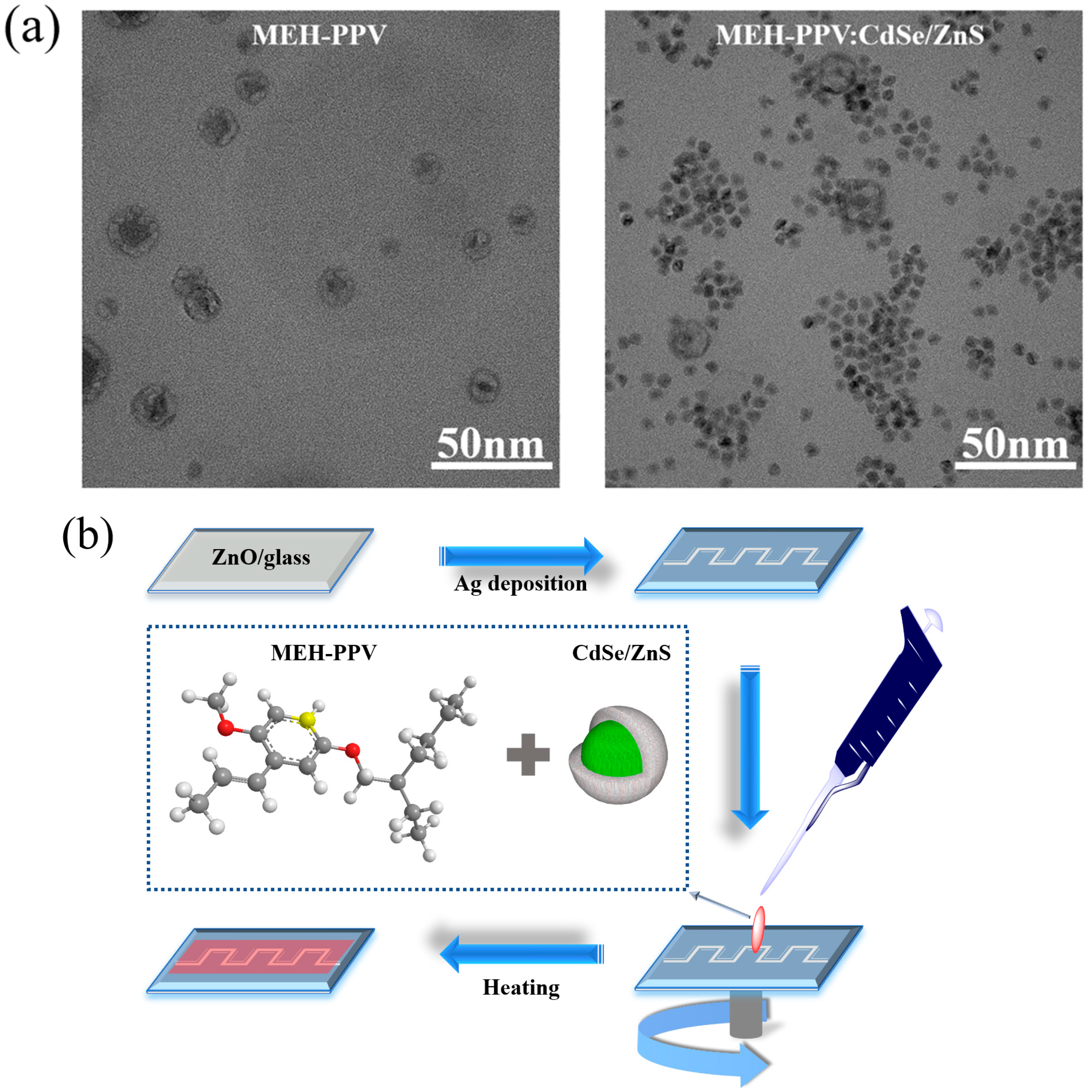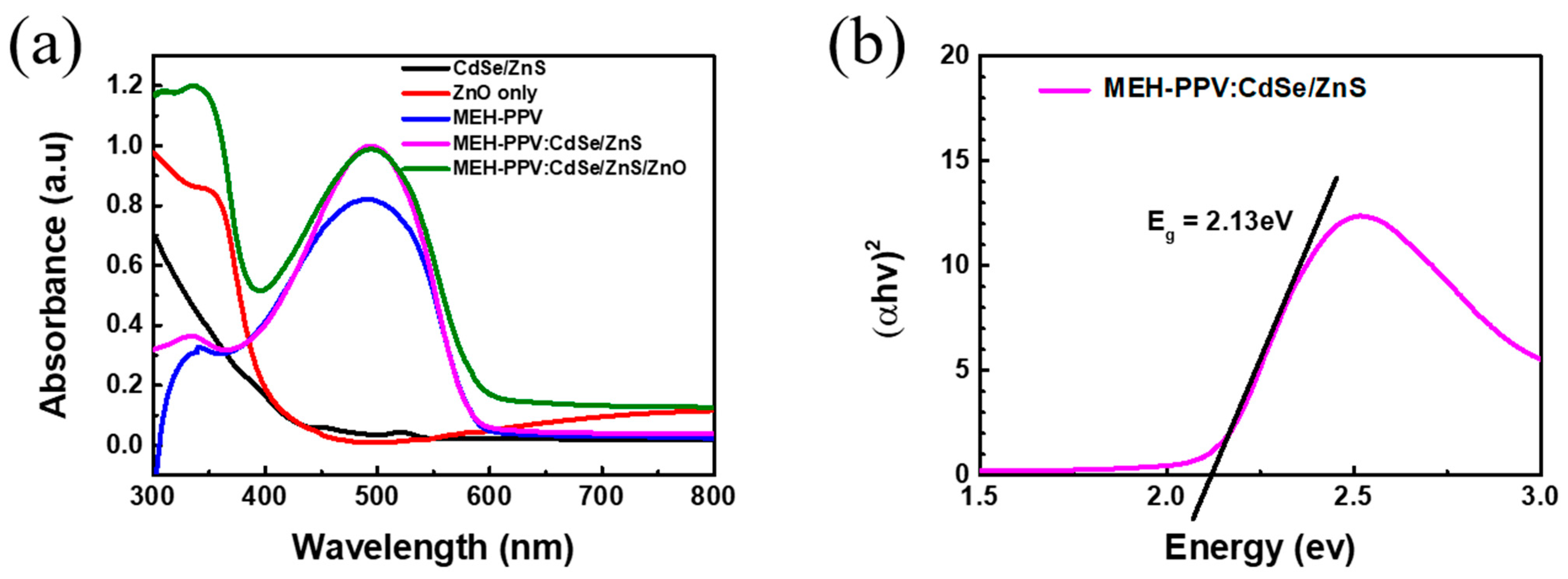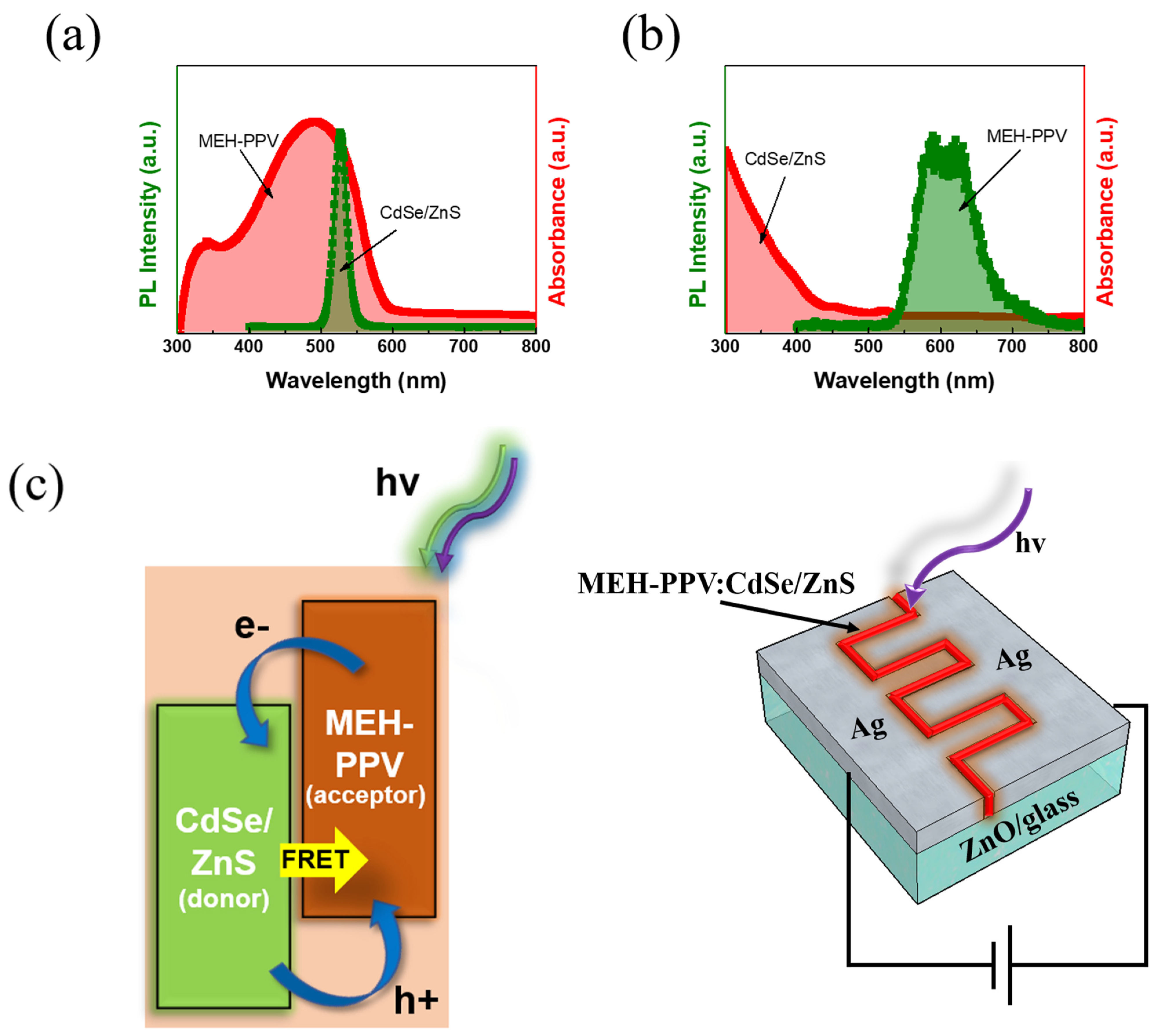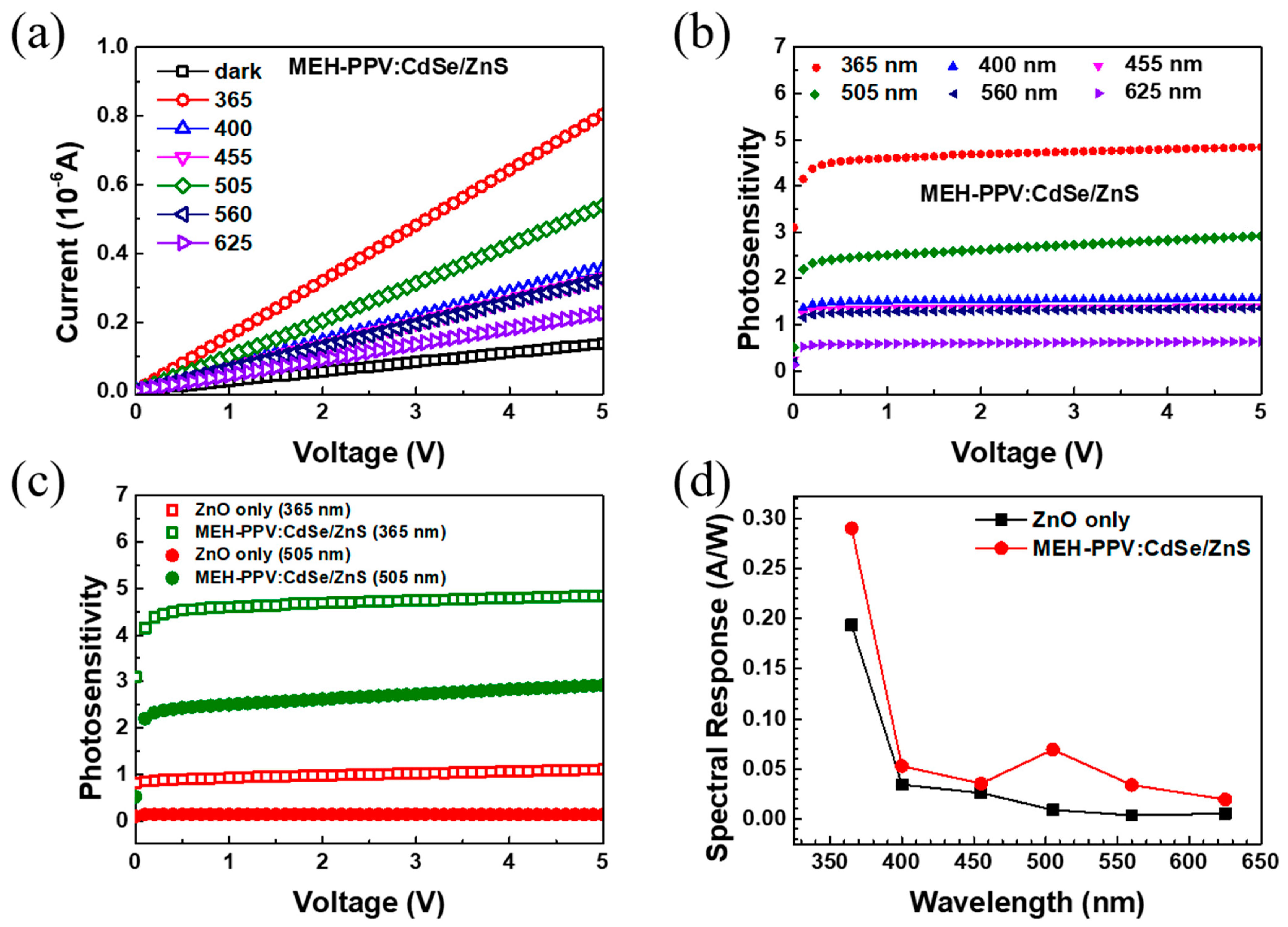Expanding the Spectral Responsivity of Photodetectors via the Integration of CdSe/ZnS Quantum Dots and MEH−PPV Polymer Composite
Abstract
1. Introduction
2. Materials and Methods
3. Results and Discussions
3.1. Absorbance Properties of MEH−PPV:CdSe/ZnS Fim
3.2. Energy Transfer between CdSe/ZnS and MEH−PPV
3.3. MEH−PPV:CdSe/ZnS Based Photodetector
3.3.1. Photodetector Mechanism
3.3.2. Photodetector Performance
4. Conclusions
Supplementary Materials
Author Contributions
Funding
Data Availability Statement
Conflicts of Interest
References
- Wang, Z.; Liu, Y.; Li, L.; Gao, S.; Zhu, D.; Yu, X.; Cheng, S.; Zheng, D.; Xiong, Y. An investigation of the effects of ZnO inverse opal pore size in the composite of ZnO nanorods/ZnO inverse opal on the performance of quantum dot-sensitized solar cells. Dalton Trans. 2023, 52, 81–89. [Google Scholar]
- Lou, C.; Wang, K.; Mei, H.; Xie, J.; Zheng, W.; Liu, X.; Zhang, J. ZnO nanoarrays via a thermal decomposition–deposition method for sensitive and selective NO 2 detection. CrystEngComm 2021, 23, 3654–3663. [Google Scholar]
- Ren, X.; Xu, Z.; Liu, D.; Li, Y.; Zhang, Z.; Tang, Z. Conductometric NO2 gas sensors based on MOF-derived porous ZnO nanoparticles. Sens. Actuators B Chem. 2022, 357, 131384. [Google Scholar]
- Wang, Y.; Herron, N. Photoconductivity of CdS nanocluster-doped polymers. Chem. Phys. Lett. 1992, 200, 71–75. [Google Scholar]
- Kim, J.-H.; Mirzaei, A.; Kim, H.W.; Kim, S.S. Combination of Pd loading and electron beam irradiation for superior hydrogen sensing of electrospun ZnO nanofibers. Sens. Actuators B Chem. 2019, 284, 628–637. [Google Scholar]
- Chen, H.-Y.; Lo, M.K.; Yang, G.; Monbouquette, H.G.; Yang, Y. Nanoparticle-assisted high photoconductive gain in composites of polymer and fullerene. Nat. Nanotechnol. 2008, 3, 543–547. [Google Scholar]
- Uddin, M.M.; Rahaman, M.H.; Kim, H.C. Highly stable hydrogen sensing properties of Pt–ZnO nanoparticle layers deposited on an alumina substrate for high-temperature industrial applications. Sens. Actuators B Chem. 2022, 368, 132088. [Google Scholar]
- Barin, Ö.; Ajjaq, A.; Çağırtekin, A.O.; Er, I.K.; Yıldırım, M.A.; Ateş, A.; Acar, S. Pivotal role of nucleation layers in the hydrothermally-assisted growth of ZnO and its H2 gas sensing performance. Sens. Actuators B Chem. 2022, 371, 132499. [Google Scholar]
- Ghasemi, B.; Ševčík, J.; Toušková, J.; Toušek, J.; Klosse, P.; Nádaždy, V.; Végsö, K.; Šiffalovič, P.; Hanulíková, B.; Urbánek, M.; et al. Trade-off between high performance and long life due to nanofiller effects in polymer LEDs: MEH-PPV/Al2O3 nanocomposite study. Appl. Surf. Sci. 2024, 657, 159807. [Google Scholar]
- Malik, H.A.; Aziz, F.; Asif, M.; Raza, E.; Najeeb, M.A.; Ahmad, Z.; Swelm, W.; Zafar, Q.; Touati, F.; Kamboh, A.H. Enhancement of optical features and sensitivity of MEH-PPV/VOPcPhO photodetector using CdSe quantum dots. J. Lumin. 2016, 180, 209–213. [Google Scholar]
- Chikalova-Luzina, O.P.; Aleshin, A.N.; Shcherbakov, I.P.; Vyatkin, V.M.; Matyushkin, L.B. Energy transfer in hybrid optoelectronic structures between perovskite nanocrystals and an organic matrix. Synth. Met. 2018, 246, 230–235. [Google Scholar]
- Ayesha, B.; Jabeen, U.; Naeem, A.; Kasi, P.; Malghani, M.N.K.; Khan, S.U.; Akhtar, J.; Aamir, M. Synthesis of zinc stannate nanoparticles by sol-gel method for photocatalysis of commercial dyes. Results Chem. 2020, 2, 100023. [Google Scholar]
- Sağlam, H.K.; Gür, E.; Ertuğrul, M. Investigation of the growth temperature effect on H2 gas detection for ZnO thin films. Opt. Mater. 2023, 137, 113521. [Google Scholar]
- Kim, M.G.; Cho, N.K.; Ma, J.H.; Park, M.H.; Park, J.H.; Jeon, W.; Kang, S.J. Controllable Layer-By-Layer CdSe/ZnS Quantum-Dot Thin Films for Enhanced Performance of Light-Emitting Diodes and Photodetectors. ACS Appl. Nano Mater. 2023, 6, 14114–14126. [Google Scholar]
- Vu, T.K.O.; Cho, I.W.; Oh, J.; Lee, D.U.; Ryu, M.Y.; Kim, E.K. Defect suppression and photoresponsivity enhancement in methylammonium lead halide perovskites by CdSe/ZnS quantum dots. J. Colloid Interface Sci. 2021, 590, 19–27. [Google Scholar]
- Sharma, S.N.; Vats, T.; Dhenadhayalan, N.; Ramamurthy, P.; Narula, A. Ligand-dependent transient absorption studies of hybrid polymer: CdSe quantum dot composites. Sol. Energy Mater. Sol. Cells 2012, 100, 6–15. [Google Scholar]
- Kisslinger, R.; Hua, W.; Shankar, K. Bulk heterojunction solar cells based on blends of conjugated polymers with II–VI and IV–VI inorganic semiconductor quantum dots. Polymers 2017, 9, 35. [Google Scholar] [CrossRef] [PubMed]
- Chang, S.-C.; Hsiao, Y.-J.; Li, T.-S. Improving the power conversion efficiency of organic solar cell by blending with CdSe/ZnS core–shell quantum dots. J. Electron. Mater. 2014, 43, 3077–3081. [Google Scholar]
- Demir, H.V.; Hernández Martínez, P.L.; Govorov, A.; Demir, H.V.; Hernández Martínez, P.L.; Govorov, A. Förster-type resonance energy transfer (FRET): Applications. Underst. Model. Förster-Type Reson. Energy Transf. (FRET) FRET-Appl. 2017, 3, 1–40. [Google Scholar]
- Dhifaoui, H.; Pegu, M.; Aloui, W.; Bouazizi, A.; Kazim, S.; Ahmad, S. Tuning of MEH-PPV electro-optical properties by incorporation of benzylidene-malononitrile-based small organic molecules. Emergent Mater. 2020, 3, 687–692. [Google Scholar]
- Shin, H.; Jang, D.; Hwang, J.; Jang, Y.; Cho, M.; Park, K. Structural characterization of CdSe/ZnS core–shell quantum dots (QDs) using TEM/STEM observation. J. Mater. Sci. Mater. Electron. 2014, 25, 2047–2052. [Google Scholar]
- Hyldahl, M.G.; Bailey, S.T.; Wittmershaus, B.P. Photo-stability and performance of CdSe/ZnS quantum dots in luminescent solar concentrators. Sol. Energy 2009, 83, 566–573. [Google Scholar]
- Förster, T. Zwischenmolekulare energiewanderung und fluoreszenz. Ann. Der Phys. 1948, 437, 55–75. [Google Scholar]
- Carter, S.; Scott, J.; Brock, P. Enhanced luminance in polymer composite light emitting devices. Appl. Phys. Lett. 1997, 71, 1145–1147. [Google Scholar]
- Kim, J.; Lägel, B.; Moons, E.; Johansson, N.; Baikie, I.; Salaneck, W.R.; Friend, R.; Cacialli, F. Kelvin probe and ultraviolet photoemission measurements of indium tin oxide work function: A comparison. Synth. Met. 2000, 111, 311–314. [Google Scholar]
- Liu, H.-W.; Laskar, I.R.; Huang, C.-P.; Cheng, J.-A.; Cheng, S.-S.; Luo, L.-Y.; Wang, H.-R.; Chen, T.-M. Enhanced phosphorescence and electroluminescence in triplet emitters by doping gold into cadmium selenide/zinc sulfide nanoparticles. Thin Solid Film. 2005, 489, 296–302. [Google Scholar]
- McDonald, S.A.; Konstantatos, G.; Zhang, S.; Cyr, P.W.; Klem, E.J.; Levina, L.; Sargent, E.H. Solution-processed PbS quantum dot infrared photodetectors and photovoltaics. Nat. Mater. 2005, 4, 138–142. [Google Scholar] [PubMed]
- Zhang, F.; Xu, Z.; Zhao, S.; Liu, L.; Sun, B.; Pei, J. Improvement of rare-earth complex electroluminescence by using organic–inorganic heterostructure. Phys. B Condens. Matter 2006, 381, 256–259. [Google Scholar]
- Karki, B.; Trabelsi, Y.; Pal, A.; Taya, S.A.; Yadav, R.B. Direct detection of dopamine using zinc oxide nanowire-based surface plasmon resonance sensor. Opt. Mater. 2024, 147, 114555. [Google Scholar]
- Bakueva, L.; Musikhin, S.; Hines, M.; Chang, T.-W.; Tzolov, M.; Scholes, G.; Sargent, E. Size-tunable infrared (1000–1600 nm) electroluminescence from PbS quantum-dot nanocrystals in a semiconducting polymer. Appl. Phys. Lett. 2003, 82, 2895–2897. [Google Scholar]
- Bakueva, L.; Konstantatos, G.; Levina, L.; Musikhin, S.; Sargent, E. Luminescence from processible quantum dot-polymer light emitters 1100–1600 nm: Tailoring spectral width and shape. Appl. Phys. Lett. 2004, 84, 3459–3461. [Google Scholar]
- Chang, T.-W.F.; Musikhin, S.; Bakueva, L.; Levina, L.; Hines, M.A.; Cyr, P.W.; Sargent, E.H. Efficient excitation transfer from polymer to nanocrystals. Appl. Phys. Lett. 2004, 84, 4295–4297. [Google Scholar]
- Lepadatu, A.-M.; Slav, A.; Palade, C.; Dascalescu, I.; Enculescu, M.; Iftimie, S.; Lazanu, S.; Teodorescu, V.; Ciurea, M.; Stoica, T. Dense Ge nanocrystals embedded in TiO2 with exponentially increased photoconduction by field effect. Sci. Rep. 2018, 8, 4898. [Google Scholar]
- Lepadatu, A.-M.; Stavarache, I.; Palade, C.; Slav, A.; Dascalescu, I.; Cojocaru, O.; Maraloiu, V.-A.; Teodorescu, V.S.; Stoica, T.; Ciurea, M.L. Enhancing Short-Wave Infrared Photosensitivity of SiGe Nanocrystals-Based Films through Embedding Matrix-Induced Passivation, Stress, and Nanocrystallization. J. Phys. Chem. C 2024, 128, 4119–4142. [Google Scholar]
- Zhao, H.; Zhao, M.; Jiang, D. Broadband photodetectors with enhanced performance in UV–Vis–NIR band based on PbS quantum dots/ZnO film heterostructure. Phys. E Low-Dimens. Syst. Nanostructures 2024, 155, 115832. [Google Scholar]
- Thyda, L.; Naresh, K.; Joseph, J.K.; Suneetha, S.; Jeyanthi, C.E.; Amaladass, P.; Selvaraju, C.; Thangaraju, K. Improved ultraviolet photodetector performances using solution-processed nitrogen-doped carbon quantum dots/ZnO hybrid thin films. Thin Solid Film. 2024, 790, 140221. [Google Scholar]
- Kadir, A.; Abdiryim, T.; Liu, X.; Jamal, R.; Tang, X. High performance Self-powered UV-visible photodetectors based on ZnO@ CdS/PEDOS heterojunctions. Sens. Actuators A Phys. 2024, 377, 115698. [Google Scholar]
- Gautam, C.; Verma, A.; Chaudhary, P.; Yadav, B. Development of 2D based ZnO–MoS2 nanocomposite for photodetector with light-induced current study. Opt. Mater. 2022, 123, 111860. [Google Scholar]
- Chen, Y.; Su, L.; Jiang, M.; Fang, X. Switch type PANI/ZnO core-shell microwire heterojunction for UV photodetection. J. Mater. Sci. Technol. 2022, 105, 259–265. [Google Scholar]
- Rana, V.S.; Rajput, J.K.; Pathak, T.K.; Purohit, L. Influence of N2 flow rate on UV photodetection properties of sputtered p-ZnO/n–Si heterojuctions. Colloids Surf. A Physicochem. Eng. Asp. 2020, 586, 124103. [Google Scholar]
- Hernandez-Como, N.; Rivas-Montes, G.; Hernandez-Cuevas, F.; Mejia, I.; Molinar-Solis, J.; Aleman, M. Ultraviolet photodetectors based on low temperature processed ZnO/PEDOT: PSS Schottky barrier diodes. Mater. Sci. Semicond. Process. 2015, 37, 14–18. [Google Scholar]




| Material | Wavelength (nm) | Bias (V) | Responsivity (A/W) | References |
|---|---|---|---|---|
| ZnO/PbS QDs | 370 | 30 | 6.332 × 10−3 | [35] |
| N–C QDs/ZnO | 365 | −8 | 96.2 × 10−3 | [36] |
| ZnO@CdS/PEDOS | UV—Visible | 0 | 7.68 × 10−3 (365 nm) 2.53 × 10−3 (450 nm) | [37] |
| ZnO-MoS2 | UV—Visible | 5 | 0.03 | [38] |
| PANI/ZnO MW | 350 | 0 | 0.56 × 10−3 | [39] |
| p-ZnO/n-Si | 365 | 5 | 0.16 | [40] |
| ZnO/PEDOT:PSS | 380 | −2 | 0.013 | [41] |
| ZnO/MEH−PPV:CdSe/ZnS | UV—Visible | 5 | 0.3 (365 nm) 0.07 (505 nm) | This work |
Disclaimer/Publisher’s Note: The statements, opinions and data contained in all publications are solely those of the individual author(s) and contributor(s) and not of MDPI and/or the editor(s). MDPI and/or the editor(s) disclaim responsibility for any injury to people or property resulting from any ideas, methods, instructions or products referred to in the content. |
© 2024 by the authors. Licensee MDPI, Basel, Switzerland. This article is an open access article distributed under the terms and conditions of the Creative Commons Attribution (CC BY) license (https://creativecommons.org/licenses/by/4.0/).
Share and Cite
Tran, T.T.; Nguyen, H.T.; Sharma, A.; Cho, Y.-B.; Kumar, M.; Yun, J.-H. Expanding the Spectral Responsivity of Photodetectors via the Integration of CdSe/ZnS Quantum Dots and MEH−PPV Polymer Composite. Polymers 2024, 16, 2371. https://doi.org/10.3390/polym16162371
Tran TT, Nguyen HT, Sharma A, Cho Y-B, Kumar M, Yun J-H. Expanding the Spectral Responsivity of Photodetectors via the Integration of CdSe/ZnS Quantum Dots and MEH−PPV Polymer Composite. Polymers. 2024; 16(16):2371. https://doi.org/10.3390/polym16162371
Chicago/Turabian StyleTran, Thanh Thao, Ha Trang Nguyen, Ankush Sharma, Young-Bin Cho, Manjeet Kumar, and Ju-Hyung Yun. 2024. "Expanding the Spectral Responsivity of Photodetectors via the Integration of CdSe/ZnS Quantum Dots and MEH−PPV Polymer Composite" Polymers 16, no. 16: 2371. https://doi.org/10.3390/polym16162371
APA StyleTran, T. T., Nguyen, H. T., Sharma, A., Cho, Y.-B., Kumar, M., & Yun, J.-H. (2024). Expanding the Spectral Responsivity of Photodetectors via the Integration of CdSe/ZnS Quantum Dots and MEH−PPV Polymer Composite. Polymers, 16(16), 2371. https://doi.org/10.3390/polym16162371








